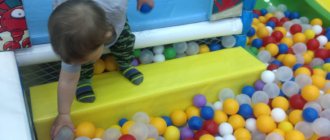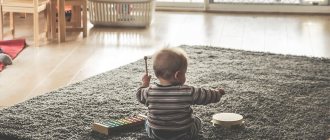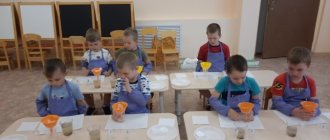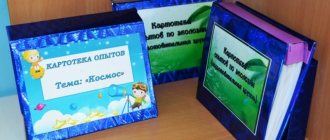Development of constructive activity in preschool age
The work of children in kindergarten is varied. This helps maintain their interest in activities and realize their comprehensive perception. One of the main types is construction and manual labor. A child’s manual labor is one of the components of his aesthetic activity; it develops children’s constructive abilities, creativity, imagination, and invention. Decorative and applied art is a child’s creative work with various materials, during which he creates useful and aesthetically significant objects and products for home decoration (games, labor, gifts for mother, leisure). By working with paper and cardboard products, the child acquires additional knowledge and practical skills, while simultaneously expanding his horizons. He develops a figurative idea of the possibilities of objects, he learns to build and create, and find unexpected uses for them. He also develops his creative imagination, which is important for any activity, both in kindergarten and at school. The fundamental point in design is the analytical and synthetic activity of studying objects. This allows you to determine the structure of the object and its parts and consider the logic of their connection. Based on analytical and synthetic activity, the child plans the progress of construction and creates a plan. The success of the implementation of a plan is largely determined by the preschooler’s ability to plan and control the progress of work.
Formation is the first, main type of activity necessary for a child in the early stages of development of visual activity. By touching objects, children develop ways of exploring objects and recognizing their shapes.
When sculpting, a child learns the three-dimensional shape of an object, the relationship of its parts, he develops skills in working with both hands, coordination of movements, small muscles of the fingers are very actively developing, and this contributes to the development of thinking, vision, and spatial thinking. It is difficult to overestimate the importance of modeling in a child's development. Modeling is the most dynamic, joyful children's art. Even small children are attracted to the opportunity to shape “real” nuts and feed them to the squirrel. Any manipulations with shaped objects and their use in play situations significantly enrich the child’s life experience. The more often a child engages in modeling, the more general and visual skills he develops. The child sets serious goals and develops constructive thinking. After all, it’s not enough to portray a person, he must also be able to stand on his feet.
Color, like shape and movement, is a means of expression in modeling. None of the children would think of sculpting Baba Yaga from pink plasticine; they always sculpt the trees in the garden of Koshchei the Immortal from dark-colored plasticine. To model dolls, they choose colors that are pleasing to the eye and find expressive details (a bright bow, decorative elements). Color is the most powerful means of expression, even in modeling. If you give a child the choice of sculpting with regular or colored clay, he will always prefer colored clay.
The application allows the child to see the outline of an object, which then becomes the basis for a graphic image that serves as a support for the development of the child's visual skills, that is, the ability to imagine an object of a certain shape. During the implementation of collages, conditions are also created for the formation of purposeful activity and the development of general intellectual abilities. In drawing, sculpting, appliqué and design lessons, children develop their language: they learn the names of colors and their shades, spatial characteristics and enrich their vocabulary. Young children are taught to paste ready-made geometric shapes and pictures onto paper. They are shown how to apply glue to them and place them on paper. The teacher involves the children in explaining the tasks and the order of their completion. During the analysis of the work, at the end of the lesson, children talk about their drawings, modeling, and express their opinions about the work of other children.
Through systematic construction and use, children intensively develop their sensory and mental abilities. Forming ideas about objects requires mastering knowledge about their properties and qualities, shape, color, size, position in space.
Children become familiar with the techniques of folding, creasing, cutting, and gluing paper. These complex concepts are easily acquired by children when creating a decorative pattern or depicting an object in parts. When learning to be productive, children learn to use materials carefully, keep them clean and tidy, and use only necessary materials in a certain order. All these points contribute to successful learning activities in all lessons.
Why is it important?
It may seem that too much attention is paid to such simple activities as modeling, drawing and assembling construction sets. From the outside it is not visible what efforts the child makes, his development does not look obvious, because the improvement of skills occurs gradually. However, do not underestimate productive activities.
The modern education system, which is undergoing constant changes, has recently come to the point that kindergartens have become part of the entire system. Simply put, a child’s development begins in the notorious “kindergarten.” There, experienced educators and teachers will help the child unlock his potential and develop all his positive qualities to the maximum.
Child development is the main task of preschool education
In the field of education, a child becomes not an object to be influenced, but a subject who himself plays a central role in his own development.
In other words, it is not the teacher who should “push” knowledge into the student, but the child himself who should strive to obtain the necessary information. This phenomenon appeared thanks to the humanization and democratization of education, when attention moves from the teacher to the student, and it is the latter who becomes the center of the educational process.
Improving the skills acquired in a preschool institution with parents will help both adults and children: it will be easier for you to understand your child, and he, in turn, will be pleased to demonstrate to his family what he can do. This is why it is important and necessary to develop productive skills.
Psychological characteristics of a preschool child
Preschool childhood is the period from the moment of awareness of oneself as a member of human society (from about 2-3 years) to the moment of systematic education (6-7 years). In this process, social factors in personality formation play a decisive role. In preschool childhood, the basic individual psychological characteristics of the child are formed, and conditions are created for the formation of social and moral characteristics of the individual.
This phase of childhood is characterized by:
- As a last resort, the child needs the help of an adult to meet the basic needs of life;
- the maximum possible role of the family in satisfying all basic needs (material, spiritual, cognitive);
- minimal possibility of self-protection from harmful environmental influences.
Appeal. By the age of six, a child’s vocabulary has expanded so much that he can easily explain to another person everything that relates to everyday life and his area of interest. While a typically developing three-year-old child uses up to 500 or more words, a six-year-old child uses between 3,000 and 7,000 words. A six-year-old child's vocabulary consists of nouns, verbs, pronouns, adjectives, numerals and connectives.
Sensory development. A child attending kindergarten not only distinguishes colors, shapes, sizes of objects and their position in space, but can also correctly name the proposed colors and shapes of objects and correctly distribute objects by size. He can also draw simple shapes and color them in a specific color. It is very important that the child can establish the identity of objects with a certain norm. Standards are humanity’s models of the main varieties of qualities and properties of objects. Thus, the standards of perception (sensory standards) are: colors of the spectrum, white and black colors, all kinds of shapes, sound levels, time intervals, etc. They arose during the history of human culture and are used by people as models, standards, with the help of which the compliance of perceived reality with one or another standard from a system of ordered standards is determined.
If a child can correctly name the color and shape of an object, if he can correlate the perceived quality with the norm, then we can assume that he can establish identity (the ball is round), partial similarity (the apple is round, but not perfectly similar to the ball), dissimilarity (the ball and cube). By carefully examining, touching or listening, the child performs correlative actions and traces the connection between what he perceives and the standard.
Development of thinking. A feature of a child’s healthy psyche is cognitive activity. A child’s curiosity is constantly aimed at understanding the world around him and forming his own picture of this world. The child plays, experiments, tries to establish cause-and-effect relationships and dependencies. For example, he himself can understand which objects will sink and which will float. He has many questions about the phenomena of life. The more intellectually active a child is, the more questions he asks and the more varied these questions become.
Development of attention. The child’s cognitive activity in exploring the world around him organizes his attention to the objects under study for quite a long time, until his interest wanes. If a six-year-old child is engaged in a game that is important to him, he can play for two or even three hours without being distracted. He can focus on productive activities (drawing, designing, work that is meaningful to him) for the same amount of time. However, such results of concentration are a consequence of interest in what the child is doing. He will languish, be distracted, and feel completely miserable when he has to engage in activities that are not suitable for him or that he does not like at all.
Memory development. Preschool age is an age of intensive memory development. It is generally accepted that memory is the leading cognitive process. In fact, a preschool child masters the language to such an extent that he becomes a true native speaker of his native language. Memory records and stores events and information that are significant to the child. Preschool childhood leaves many memories that will last a lifetime.
A six-year-old child can already voluntarily remember objects. When memorization becomes a condition for successful play or is important for the realization of a child’s aspirations, he easily remembers words in a certain order, poems, sequences of actions, and so on. A six-year-old child is already consciously able to use memorization techniques. He repeats what needs to be remembered, tries to understand, assimilate what was memorized in a certain order. However, involuntary memorization remains more productive. Here, too, everything is determined by the child’s interest in what he is doing.
Development of imagination. A six-year-old child can create in his imagination many situations in which he appears at his most beautiful. Having formed in the game, the imagination moves into other types of activities. This is most clearly manifested in drawing and in writing children's rhymes and fairy tales. Here there is great variability in the nature of children's creativity: some children are focused on recreating real reality, others on creating fantastic images and situations. Fantasy plays a greater role in the life of a child than in the life of an adult; it manifests itself much more often and allows more frequent violations of the reality of life. The tireless work of imagination is the main way a child learns and masters the world around him; it is a way to go beyond the limits of narrow personal experience.
What is children's productive activity?
The concept of “productive activity” suggests that the result of certain actions should be a certain product.
Preschool children are more process-oriented. By performing various actions, they learn about the world around them. Kids love to take a toy apart down to the last screw just to see what's inside. Creation and production of a product are not very compatible with preschool age. However, depending on what you mean by a product of children's efforts.
The productive activity of preschool children is aimed at creating a real product in the form of a drawing, craft, design, applique, crocheted square under the supervision of a grandmother and similar products.
The main feature of the productive activity of preschoolers is the emergence and materialization of a plan. If in a game the idea is realized through actions and communication, then in this case the child receives a specific product.
Productive activity has a huge impact on the development of a preschooler’s perception. When making a craft or design, the child learns object properties and relationships, understands shape and size. These characteristics become accessible to the baby’s understanding only when he puts them into practice.
Bottom line
As you can see, productive skills developed in preschool age have a lot of advantages:
- development of the pupil’s aesthetic and moral feelings;
- improving his mental and physical aspects;
- formation of concepts about space, form, composition;
- acquisition of additional skills in working with tools and office supplies;
- development of perseverance, hard work, logic.
And in order to achieve all this, you don’t need to do much: provide the baby with all the necessary materials and together with him try to make a craft, sculpt a figurine or draw a picture.
This will bring pleasure to both you and your child, and will help him take another step towards his successful education. leave a comment




